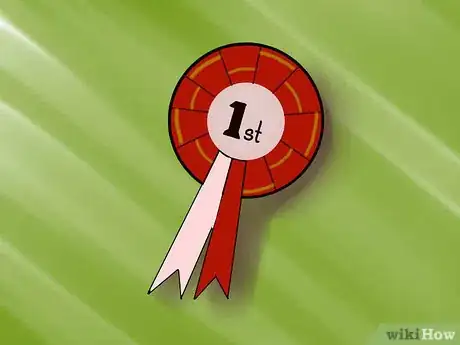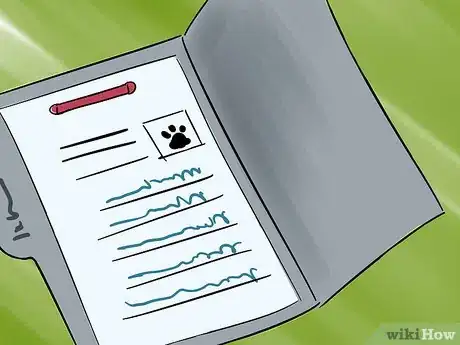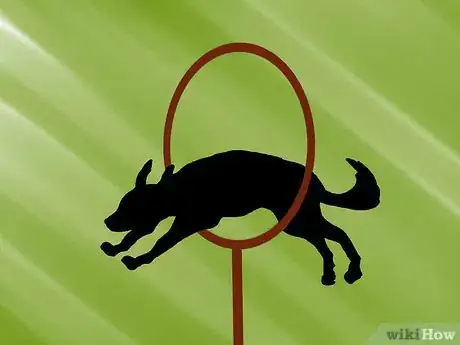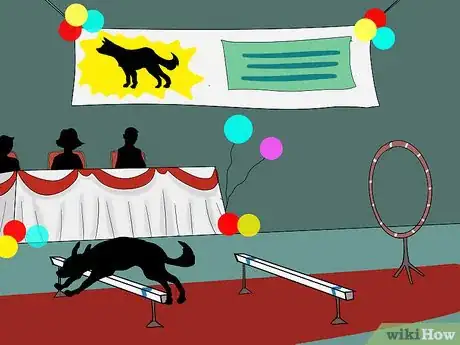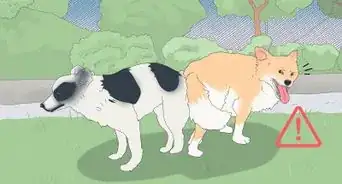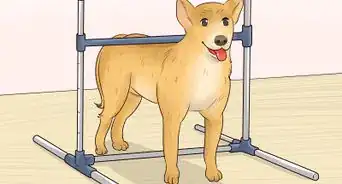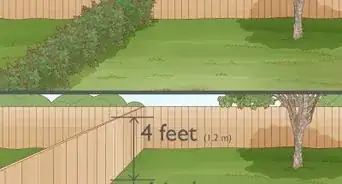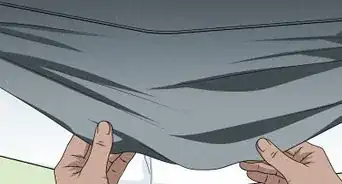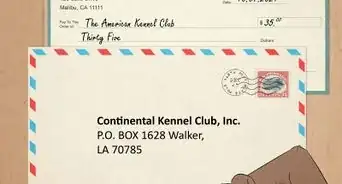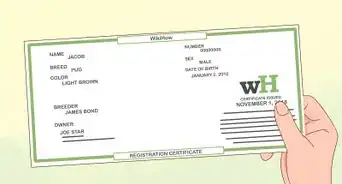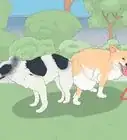This article was co-authored by Nicole Larocco-Skeehan. Nicole Larocco-Skeehan is a Dog Trainer and the Owner of Philly Unleashed in Philadelphia, Pennsylvania. Nicole has over 25 years of experience working with animals and currently specializes in group and private dog training and behavior modification. Nicole’s business has been named the "Best of Philadelphia" and she is the author of “The Teaching Dog: Partnering with Dogs for Instruction, Socialization, and Demonstration in Your Training Practice.” She was also on the Certification Council for Professional Dog Trainers Board of Directors. Nicole holds a Bachelor of Science in Marketing and Advertising from Robert Morris University.
wikiHow marks an article as reader-approved once it receives enough positive feedback. In this case, 100% of readers who voted found the article helpful, earning it our reader-approved status.
This article has been viewed 48,997 times.
Organising a dog show, even if it is just for a small group of people, is a rewarding exercise and everyone involved will have a lot of joy from the occasion. If you set up suitable courses, you can do agility with dog shows as well. And while it's perfect for showing off your and your friends' dogs, it is also a good way to raise money for a charity.
Steps
Planning for the Dog Show
-
1Make sure you are properly covered. Do you have insurance? Do you have a license? Once that is sorted, you can continue.
-
2Put out a call for volunteers. To run a successful fun dog show, you’ll need lots of reliable people to help you out. Assign each volunteer a job and make sure everyone knows their role.Advertisement
-
3Begin by organizing the place you are going to do the show. Make sure that you are allowed to hold a public event here. Also, decide what to do if it rains. Is it indoors? Will it get muddy? Is there somewhere to do agility if you are holding that event? Make sure that once you have your venue, book it with plenty of time to organize everything else.
- Village/school halls with access to a playing field are good choices. Marquees are another option but can be expensive. You will also most likely need good parking facilities for spectators and competitors. Also make sure you have suitable toilet facilities.
- If you have a second ring for agility/obstacle course or obedience, then a notice of that ring’s purpose should be displayed on a prominent noticeboard.
- The ring should be large enough for the contestants to stand along 2 sides and maybe partway down the third side. For a 6 class novelty type show, consider a ring of some 20 meters (65.6 ft) by 20 meters (65.6 ft). If the contestants are stood along 4 sides, then the ring is too small for purpose, so make it bigger. Spectators should be able to sit along at least 2 sides of the ring, if not 3.
-
4Decide how serious your show will be. More serious shows use qualified and experienced judges. Fun dog shows are just that––fun––and should be taken less seriously by all concerned. With either, however, you need to plan out a good show program with the right number of classes, etc.
-
5Choose judges. If you have access to professional judges, use them. Otherwise, use volunteers who are willing to do it. Either way, they should have experience with dogs.
Setting Up the Events
-
1Decide all of the classes you will have for the show. If you are stuck for ideas, you can look up classes. Here are some ideas:
- Suggested Pedigree Classes
- Puppy - Any breed (6 - 12 months)
- Yearling - Any breed (12 - 24 months)
- Gun-dog - Any breed
- Hound and Terrier - Any breed
- Working or Pastoral - Any breed
- Toy and Utility - Any breed
- Any Variety - Open
- Suggested Novelty Classes
- Best Veteran - Any breed (7 years and over)
- Best Crossbreed
- Best Rescue Dog - Any dog that has come from an animal shelter.
- Most Handsome Dog
- Prettiest Bitch
- Most Appealing Eyes
- Waggiest Tail
- Best Condition
- Best Brace - 2 dogs alike
- Best Irish Brace - 2 dogs of different types
- Best 6 legs - Dog and Owner
- Best Junior Handler
- Dog The Judge Would Most Like To Take Home
-
2Include some dog agility options. Dog agility classes are often included at dog shows but usually as an interesting novelty. Owners are invited to let their dogs have a try-out at various challenges such as walking along planks, over hurdles or in and out of sticks etc. These competitions are usually just a bit of fun and an added attraction to your fundraising event.You may however like to consider inviting your local dog agility club. These clubs are often keen to demonstrate the skills of their pets and regularly feature in all sorts of summer fundraising events. A run-through of their routines can make a great attraction at your event.
-
3Have awards. It is traditional to give rosettes to the winners of every class, with a larger and more colourful rosette to the Best In Show Winners. Some shows give rosettes to the first four places, whilst some shows have rosettes down to 6th place. You do not have to award six places in every class. You could also do certificates. Remember do order these early and in plentiful supply. Cups are also a good option.
Get Word Out
-
1Advertise out space so local dog related companies can come and demonstrate their products and/or services. You can also hold little raffles, tombolas, etc.
-
2Advertise the event. Make posters, put notices in newsagents’ windows or on council notice boards, use local newspapers and radio stations, and advertise on Facebook. Make noise and get the word out there. You will want to do this anywhere from a month before to a couple of weeks before, depending on how much publicity you want.
On the Day
-
1Set up. Depending on how early you are allowed at the venue, you may need to get a wiggle on. Lots of volunteers are useful. If you are running an agility course you will need to set up, plan and number a course.
- If you cannot obtain dog agility jumps, make your own. For example, you could use barstools with brooms that sit on the rungs between the stools. Or, use an old unwanted ottoman and other seating from the local charity store. Another option is to use wine or soda crates as jumps.
- A tunnel could be made using folding chairs with sheets draped over them.
- Be inventive, there are many possibilities to rustle up jumps, tunnels and other agility or obstacle items that are cheap, free and safe for dogs.
-
2Check the health and safety is in order. Think about the venue and activities that you’ve chosen. Is there anything that could put a dog or owner at risk?
- Vets — you should have a vet on hand should a dog need medical attention. You could ask a local vet to be a judge as well (see above).
-
3Enjoy the day. No need to panic, you've got it all sorted but do keep an eye on everything to make sure it all runs smoothly. Be a good host and check everyone is enjoying the day.
Community Q&A
-
QuestionHow can I advertise a fun dog show using email, Facebook or other dog-related sites?
 Community AnswerDesign a colorful poster with some pictures of dogs and the details of the dog show. Then encourage others to post and share.
Community AnswerDesign a colorful poster with some pictures of dogs and the details of the dog show. Then encourage others to post and share. -
QuestionCan I use this for a horse show?
 Community AnswerYes, they are very much the same.
Community AnswerYes, they are very much the same. -
QuestionCan I do the same sort of things, but for a cat show?
 Community AnswerYes, but that would include serious, long-term training for the cats. Dogs are easier to train than cats.
Community AnswerYes, but that would include serious, long-term training for the cats. Dogs are easier to train than cats.
Warnings
- Advertise it well, otherwise there is less chance of people going with dogs⧼thumbs_response⧽
- Keep the dogs well under control⧼thumbs_response⧽
- Do not enter your dog in the show, if you are judging. You may want to go for him!⧼thumbs_response⧽
- Remember 3rd party insurance ECT. As named above.⧼thumbs_response⧽
Things You'll Need
- Insurance
- Volunteers
- A venue
- Toilet facility's
- An official's tent
- Agility jumps etc. for agility
- A judge/s
- Netting or fencing for the arena
- Prizes, rosettes, trophy's certificates ECT.
- Paperwork
- Dogs







